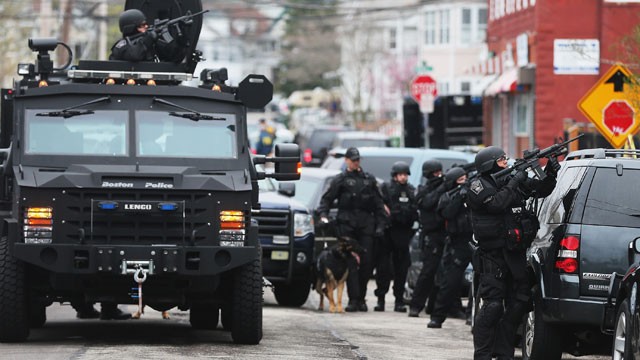| BOSTON | The Economist.
TO HELP
friends and family members find one another amid the crowds expected at this
year’s Boston marathon, the organisers set up a series of meeting points in the
streets around the finish line. The bright yellow and orange signs are still
there, but most of the planned reunions were thwarted—and a few will never now
take place—thanks to the two bombs that blew up on April 15th near the end of
the course in the closing stages of the race.
The
explosions, separated by 600 feet (180 metres) and 12 seconds, killed three
people: an eight-year-old boy and two young women. Another 180 or so were
injured. At least 13 people lost limbs. That makes the attack the most deadly
act of terror in America since September 11th 2001, apart from mass shootings.
To add to the alarm, the authorities intercepted two letters, one addressed to
Barack Obama and another to Roger Wicker, a senator, which appeared to contain
ricin, a lethal poison. A fire followed by an explosion at a fertiliser factory
in west Texas on the night of April 17th, which killed at least five people,
increased the sense of apocalypse. But as The Economist went to press there was
still no indication that this was anything but a horrific accident.
Shortly
after the Boston bombing Mr Obama vowed that “any responsible individuals, any
responsible groups will feel the full weight of justice.” The FBI, sifting
through the mass of video footage and photographs provided by broadcasters,
security cameras and bystanders, homed in on shots of two individuals who
officials believe may be responsible for the bombs. But their whereabouts,
identity and motives remained a mystery. An aggrieved constituent of Mr Wicker
was arrested on April 17th, suspected of sending the poisoned letters; but he
has not been tied to the bombings.
Boston is
now flooded with police, soldiers and other security forces, both to ward off
further attacks and to help with the investigation. State troopers stand watch
outside metro stations; whole squadrons of national guardsmen march back and
forth on Boston Common, a park a few blocks from the site of the bombings.
Barricades festooned with flowers and notes of condolence block access to the
immediate area of the blasts, as investigators pore over it in the hunt for
evidence.
Fragments
retrieved from the scene suggest that the bombs were constructed from six-litre
pressure-cookers packed with gunpowder, a simple detonator and shrapnel in the
form of nails and ball-bearings, intended to cause horrific injuries.
The simple
but effective design of the bombs, which may have cost as little as $100 to
make, is similar to countless improvised explosive devices (IEDs) that have
inflicted casualties on civilians and Western troops in Afghanistan and Iraq.
Instructions for building such bombs can be easily found on the internet. The
bombs’ lack of sophistication suggests they were either the work of a lone
individual or a small group with limited resources.
In 2010 an
online magazine, Inspire, published by al-Qaeda in the Arabian Peninsula, ran
an article entitled “How to make a bomb in the kitchen of your mom”. Inspire,
aimed at aspiring young jihadists in America and Britain, was edited by Anwar
al-Awlaki and Samir Khan. Both were American citizens who were killed by the
same drone strike in Yemen in 2011.
However,
the fact that pressure-cooker bombs are popular with al-Qaeda operatives is far
from conclusive evidence that the Boston bomber had jihadist aims or
connections. America has suffered several terrorist attacks by native-born
extremists with domestic grievances, such as the IED set off near the Olympic
stadium in Atlanta in 1996, or the bombing of a federal office building in
Oklahoma City in 1995.
The
bombings in Boston took place as locals celebrated (four days early) Patriots’
Day, the anniversary of the first skirmish in America’s war for independence.
The date could be significant to the sort of radicals who believe the federal
government is bent on the destruction of their liberties and the confiscation
of their guns, especially as it coincides with the anniversaries of two violent
episodes involving like-minded people: the end of the siege of the compound of
a heavily armed cult in Waco, Texas, on April 19th 1993, and the Oklahoma City
bombing exactly two years later. April 15th is also the day by which federal
income-tax returns must be filed, another flashpoint for many.
Mr Obama’s
re-election and his support for immigration reform and gun-control legislation,
however ill-fated, have enraged this extremist fringe. The Southern Poverty Law
Centre (SPLC), a civil-rights organisation that tracks and exposes the
activities of right-wing extremists, says that outfits of this kind have
proliferated during his presidency, from around 150 in 2008 to an all-time
record of 1,360 last year (see chart).
The SPLC
estimates that of those about 1,000 could be classified as “hard-core”, and
thus by implication capable of violence. Among recent incidents, it points to
the murder of six people at a Sikh temple in Wisconsin by a neo-Nazi gunman
last August and the rounding up, also last year, of a murderous militia group
based in Georgia, which included several active-duty soldiers. According to
prosecutors, the group, which called itself FEAR (Forever Enduring, Always
Ready), had stockpiled $87,000 worth of weapons and explosives, and was
plotting to overthrow the government through a campaign of terror and
assassinations.
If the
perpetrator is identified it will have political ramifications. If the bomber
is a jihadist, Mr Obama can expect to be taken to task for complacently
declaring victory over al-Qaeda courtesy of his drone campaign. If it is a
home-grown nut, Republicans can expect some blame for not stamping more firmly
on the furious claims made about Mr Obama from the right’s wilder shores. And
there is always the possibility that the bomber is an awkward combination of
the two: a home-grown Islamic loner.
From the
print edition: United States







